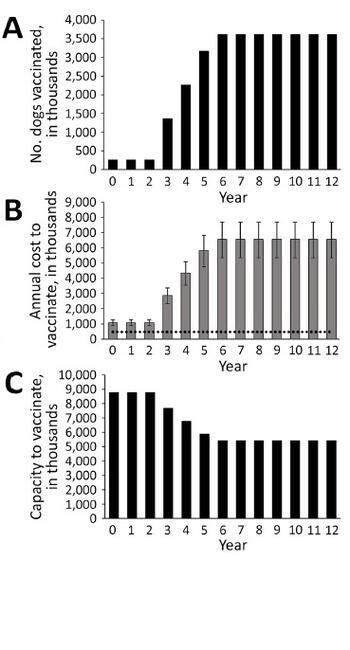A planning tool for eliminating human rabies deaths through mass dog vaccination
In 2016, the World Health Organization (WHO), the World Organization for Animal Health (OIE), the Food and Agriculture Organization (FAO), and many non-governmental organizations (NGOs) released a framework to achieve the joint goal of eliminating dog-mediated human rabies by 2030. But the goal requires overcoming substantial challenges. Dog-rabies endemic countries are at different stages in their control efforts; most countries have to overcome important hurdles, including limited public health infrastructure, competing health and social priorities, poor understanding of the local epidemiology, logistic and operational concerns, not enough trained vaccination personnel, and/or insufficient planning capabilities to project resources needed to run a successful dog-vaccination campaign.
Drawing from multiple datasets, including national dog vaccination campaigns, rabies literature, and expert opinion, researchers at the US Centers for Disease Control and Prevention (CDC) roughly estimated the resources needed to achieve the elimination of dog-mediated human rabies deaths by 2030, based on World Health Organization (WHO) recommendation of vaccinating 70% of the dog population for several years to eliminate dog rabies. Their aim was to describe the global rabies situation, highlighting some of the main challenges that may complicate elimination efforts in a consistent framework, the Global Dog Rabies Elimination Pathway (GDREP).
The GDREP focuses of four key factors that determine rabies elimination efforts: country development, cost of dog vaccination programs, potential demand for dog rabies vaccine, and available vaccinators. But while those global estimates may help stimulate and inform the ongoing discussion about rabies elimination, they may not help inform country-level decision making toward rabies elimination.
The researchers have now addressed this limitation by making public the first of a series of user-friendly spreadsheet tools requiring only limited country-specific data, to assist countries in their planning efforts towards the goal of eliminating dog-rabies through mass dog vaccination. Specifically, this first planning tool helps users to estimate the time and overall costs required to achieve the elimination dog mediated human rabies deaths by 2030, based on the GDREP framework. Outputs from the planning tool allow programme managers to predict workload, budget and capacity needs for an elimination campaign (see figure).
To use the tool, users need to input demographic data (human population, percent urban, human-to-dog ratio), current dog vaccination coverage, logistic data for the campaigns (available vaccinators, dog vaccination rates, campaign duration), and an estimated cost per vaccinated dog. The tool provides default values based on publicly available data, but country-users can improve these input values based on local expertise and statistics.
The spreadsheet-based planning tool is available for download via the technical appendix here and a collaboration with GARC has developed an online version of the same tool which can be accessed here.
Contributed by Eduardo A. Undurraga, part of the CDC team that developed the tool, now based at Pontificia Universidad Católica de Chile. More details about the use of the GDREP for global modelling are available here and about the planning tool here. GARC’s web developer, Andy Hebrank developed the online version of the tool.
